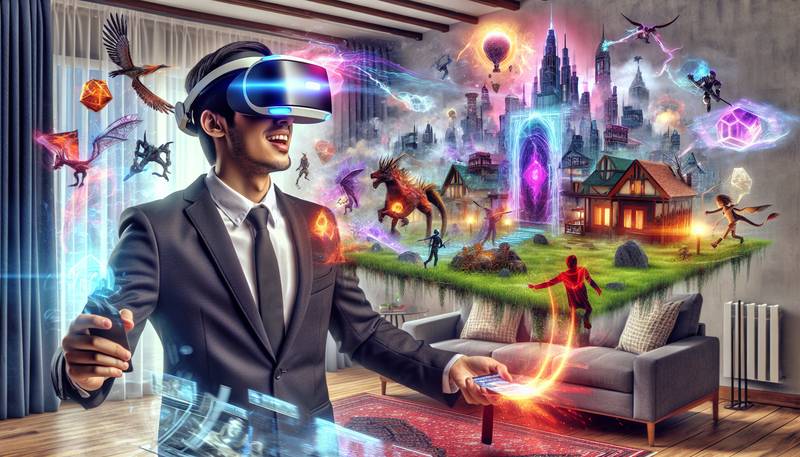Augmented Reality Gaming: Blending Worlds

Augmented reality (AR) gaming is a technology that is rapidly changing the way we experience and interact with video games. With the ability to overlay digital content onto the real world, AR gaming is blurring the line between reality and virtual reality, creating a whole new gaming experience that is both immersive and interactive.
What is Augmented Reality Gaming?
AR gaming is a type of video game that uses augmented reality technology to superimpose digital content onto the real world. This can include anything from 3D models and animations to interactive elements that respond to the player's actions. AR games are typically played on smartphones, tablets, or specialized AR headsets, and they use the device's camera to capture the real-world environment and overlay digital content onto it.
The Rise of AR Gaming
AR gaming first gained widespread attention with the release of Pokémon Go in 2016. This mobile game quickly became a cultural phenomenon, with millions of players around the world using their phones to catch virtual Pokémon in their real-world surroundings. The success of Pokémon Go showed the potential of AR gaming and sparked a wave of development in the field.
The Future of AR Gaming
Since the release of Pokémon Go, AR gaming has continued to evolve and improve. Advances in AR technology have made it possible to create more realistic and interactive experiences, and the range of AR games available has expanded to include a variety of genres, from puzzle games to action games to educational games.
How AR Gaming Works
AR gaming relies on a combination of hardware and software to create the augmented reality experience. The hardware, such as a smartphone or AR headset, is equipped with a camera and sensors that can detect the player's movements and the surrounding environment. The software then uses this information to overlay digital content onto the real world, creating the illusion of a blended reality.
The Importance of Hardware
The quality of the AR gaming experience is heavily dependent on the hardware used. High-quality cameras and sensors are essential for accurately capturing the real-world environment and creating a seamless blend between the digital and physical worlds. Similarly, a powerful processor and graphics card are needed to render the digital content in real-time and create a smooth and realistic experience.
The Role of Software
The software used in AR gaming is also crucial to the experience. It must be able to accurately track the player's movements and the environment, as well as respond to the player's actions in real-time. The software must also be able to render the digital content in a way that is realistic and believable, creating the illusion that the virtual objects are truly part of the real world.
The Benefits of AR Gaming
AR gaming offers a number of benefits over traditional video games. For one, it allows players to interact with the game in a more physical and active way, as they must move around and interact with the real world in order to play. This can make AR gaming more engaging and immersive, as well as provide a more active and social gaming experience.
AR Gaming and Education
AR gaming also has the potential to be a powerful educational tool. By overlaying educational content onto the real world, AR games can make learning more interactive and engaging. For example, an AR game could be used to teach history by bringing historical events to life in the player's surroundings, or to teach science by allowing players to interact with virtual models of molecules and atoms.
AR Gaming and Social Interaction
AR gaming can also encourage social interaction, as many AR games are designed to be played with others. This can be a great way to bond with friends and family, as well as meet new people who share a common interest in gaming. The ability to play games in the real world also makes AR gaming more accessible to people who may not have access to traditional gaming consoles or computers.
The Challenges of AR Gaming
Despite its many benefits, AR gaming also faces a number of challenges. For one, the technology is still relatively new and can be expensive, limiting access for some players. There are also concerns about privacy, as AR games often require access to the player's location and camera. Additionally, there are technical challenges to overcome, such as creating realistic and seamless blends between the digital and physical worlds, and ensuring that the games run smoothly on a variety of devices.
Privacy Concerns
Privacy concerns are a major issue for AR gaming, as the games often require access to the player's location and camera. This can raise questions about how the data is being used and who has access to it. It is important for developers to be transparent about their privacy policies and for players to be aware of what information they are sharing.
Technical Challenges
The technical challenges of AR gaming are also significant. Creating a realistic and seamless blend between the digital and physical worlds is a complex task that requires advanced technology and expertise. Ensuring that the games run smoothly on a variety of devices is also a challenge, as different devices have different capabilities and limitations.
Conclusion
AR gaming is an exciting and rapidly evolving field that is changing the way we experience video games. With the ability to blend the digital and physical worlds, AR gaming is creating new and immersive experiences that are both fun and educational. While there are challenges to overcome, the potential of AR gaming is vast and the future looks bright for this emerging technology. Whether you're a seasoned gamer or new to the world of AR, there's never been a better time to jump into the world of augmented reality gaming and experience the thrill of blending worlds.


